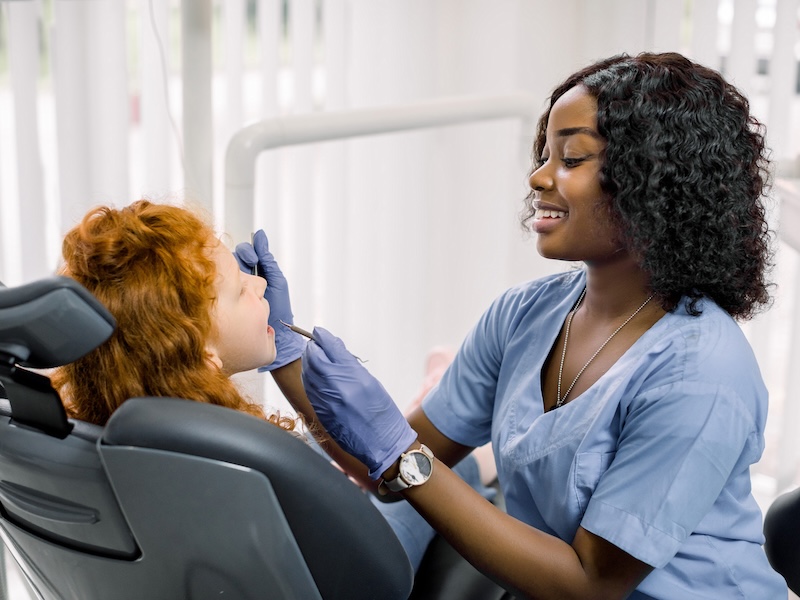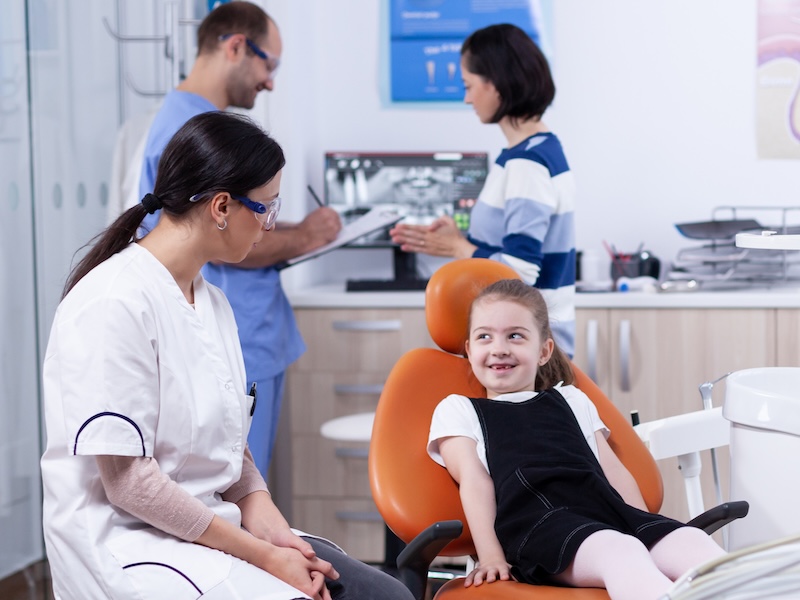Effective communication is a critical factor in dental patient satisfaction. More than 93% of patients who gave the highest satisfaction ratings cited communication with the dental office as an essential part of the rating.
One of the most important components of providing an exceptional patient experience at your dental practice is how you interact with your patients. Your entire dental staff plays an important role in setting the tone and providing efficient and friendly service for patients.
Why is communication so important in dentistry?
The quality of patient communication sets the foundation for a positive patient experience and strengthens the patient-provider relationship. Dental practices rely on more than technical skill alone; soft skills, like active listening, empathy, and clarity, play a critical role in how patients perceive their care. When dental staff listen attentively, address concerns with patience, and explain procedures in straightforward language, patients feel valued and respected. This approach to dental patient management builds trust, making patients more likely to follow recommended treatments and experience better outcomes.
Communication also shapes patients’ overall perception of a dental practice. Favorable interactions leave patients feeling comfortable and confident in their care, which not only improves their satisfaction but can also influence word-of-mouth referrals. A patient who feels understood and well-cared-for is more likely to recommend the practice to friends and family. This ripple effect can help dental offices attract new patients, contributing to steady growth–without the need for costly marketing for dental practices.
Moreover, effective dental patient communication is crucial for retention, which is key to long-term success. Patients who feel their concerns are heard and their needs are met are more likely to return for regular check-ups and additional treatments. This continuity benefits both the patient and the practice, as retained patients are often more comfortable with treatment recommendations and more likely to maintain a proactive approach to their oral health. By making communication a priority, dental practices can enhance patient loyalty, improve treatment adherence, and build a positive reputation within the community.
What is a patient-centered approach to providing dental care?
A patient-centered approach in dental care focuses on understanding and addressing each patient’s unique needs, anxieties, and preferences. This approach prioritizes compassionate communication to create a comfortable, welcoming environment, helping patients feel valued and understood. By listening to patient concerns and acknowledging their specific challenges, dental providers can reduce stress and build a stronger, more trusting relationship.
An essential part of patient-centered care is helping patients feel informed and involved in their own treatment plans. By explaining diagnoses and treatment options in easy-to-understand terms, dental teams ensure patients fully understand their care journey. This inclusive communication style encourages patients to ask questions, voice concerns, and actively participate in decision-making, ensuring they feel empowered and supported throughout the process.
Additionally, a patient-centered approach acknowledges that every patient’s journey is unique. It provides a flexible care model where patients feel confident that their specific needs are met, from treatment planning to follow-up. This personalized care not only enhances patient satisfaction but also improves treatment outcomes, fosters patient loyalty, and drives word-of-mouth referrals, ultimately contributing to practice growth.
How dentists can improve patient-focused communication
Improving patient-focused communication is essential for building trust and delivering exceptional care. It’s not just about what you say but how you make your patients feel. When communication is clear, compassionate, and responsive, patients are more likely to feel at ease and engaged in their treatment. Below are key strategies dentists can implement to foster better communication with patients:
- Practice Active Listening
- Be Empathetic and Compassionate
- Provide Clear Explanations
- Build Rapport
- Establish Trust
Practice active listening
Active listening goes beyond simply hearing a patient’s words—it requires being fully present and attentive to their concerns. When a patient feels heard, they are more likely to trust their provider and open up about their needs. Encouraging them to express their worries or questions without interruptions is essential in showing that you value what they have to say. Maintaining eye contact, nodding, and using verbal cues like “I understand” or “Go on” can help signal that you are genuinely engaged in the conversation. This creates a safe space for patients to share important details they may otherwise hesitate to disclose.
Additionally, active listening involves reflecting on what the patient has communicated. Asking follow-up questions to clarify any uncertainties and paraphrasing their main points helps ensure that you fully grasp their concerns. This approach also allows patients to correct any misunderstandings early on, which can prevent miscommunication and lead to more accurate diagnoses and tailored treatment plans. By making active listening a core part of patient interactions, you foster trust, enhance communication, and ultimately contribute to a more positive and collaborative dental care experience.
Be empathetic and compassionate
Dental visits can be stressful for many patients, which is why empathy and compassion are crucial. Taking the time to acknowledge a patient’s fears or anxieties can go a long way in helping them feel more comfortable. Use gentle reassurance, validate their feelings, and offer solutions to alleviate any stress. When patients feel that you genuinely care about their well-being, they’re more likely to feel relaxed and confident in your care.
Provide clear explanations
Dental jargon can be confusing or overwhelming, especially for patients unfamiliar with medical terminology. Make it a priority to explain diagnoses, procedures, and treatment options in simple, easy-to-understand language. Take the time to walk patients through the steps of their treatment, and encourage them to ask questions. Clear explanations not only improve understanding but also empower patients to make informed decisions about their dental health.
Build rapport
Building rapport with patients creates a stronger, more personal connection that can enhance their overall experience. Take a moment to ask about their lives, hobbies, or how they’re feeling outside of their dental health. Small gestures like remembering a detail from a previous visit or expressing genuine interest in their well-being can foster loyalty and trust. A strong rapport makes patients feel valued, leading to better retention and long-term relationships.
Establish trust
Establishing trust with patients is essential for fostering open and effective communication. One of the best ways to build trust is by being transparent and inclusive when discussing their dental concerns and treatment options. Patients want their provider to be honest and forthcoming. This means clearly explaining the diagnosis, outlining all treatment options, and discussing potential risks and benefits without using confusing jargon. When patients have full visibility into their situation, they are more likely to feel confident in their care and trust that they are receiving the best advice.
In addition to transparency, involving patients in the decision-making process helps build a stronger sense of trust. Encourage patients to ask questions and voice any concerns they may have, and make sure they understand the reasoning behind each treatment option. By giving them a role in their own care and acknowledging their preferences, you empower patients to take ownership of their dental health. This collaborative approach not only strengthens the patient-provider relationship but also leads to higher satisfaction and better long-term outcomes.
Leveraging technology to improve dental patient communication
Dental patient communication software can be an invaluable tool for dental clinics that are looking to streamline dental patient management, improve patient engagement, establish best practices that enhance overall communication with patients and increase dental case acceptance rates.
AI dental receptionist software helps dental offices provide the best patient experience because it can interact in complex conversations using natural language. Popular conversational AI for dental practices include two-way texting options that allow for secure messaging between the practice and patients, dental appointment reminders which help to eliminate missed appointments, and automated patient recalls that help to keep clients up-to-date with their treatment plans. With communication software you have the possibility of streamlining your entire workflow from patient arrival through treatments.
An essential component of patient service is appointment booking. Offering online or SMS-based booking improves the patient experience. People are used to scheduling all types of services online when its convenient. However, only one out of four dentists offer online scheduling. This means offering it can not only improve your communications with patients, but it can also give you a competitive advantage.
TrueLark dental patient communication software
TrueLark is the only fully-developed AI-powered communication platform that automates interactions end-to-end using advanced conversational Artificial Intelligence. Book a demo to learn how it can improve your individual practice or DSO network.
Originally published March 14, 2023. Updated November 11, 2024.




















